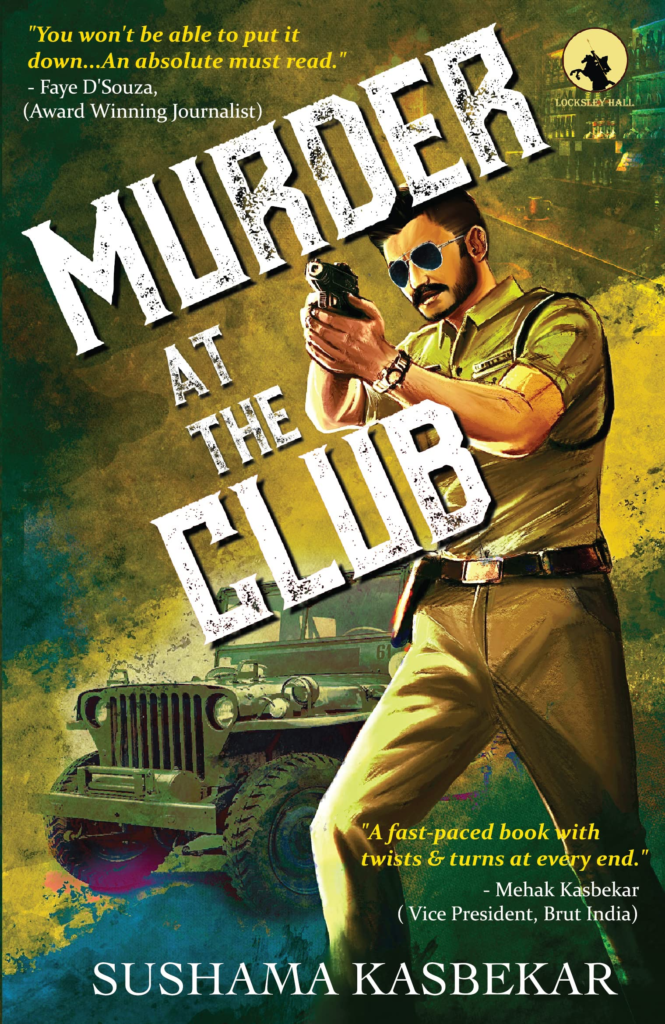Murder at the club: Rich, Pulpy Goodness

I am usually cautiously optimistic any time I pick up a book by an author I have never read before. Many times, an author’s style is just not your thing, even if the author themselves might be competent, even gifted writers, So, I approached Sushma Kasbekar’s Murder At The Club with the same caution. However, having devoured the short 200 page book in a single sitting late on a Saturday night, I feel that my caution was premature and thoroughly unnecessary.

Murder At The Club is the author’s debut Murder mystery novel, set in 1990s Indore. It follows, in some ways, Inspector Virendra Chaudhary as he tries to solve the murder of a 38 year old woman from his own past, that has happened in a posh club frequented by the high society of the city. However, despite being the protagonist, he is not the central focus of the story. The story instead uses the murder mystery setting to intelligently craft a commentary on the society of the 1990s.
Incidentally, my favorite parts of the book weren’t even the ones that had anything to do with the murder mystery. I was more taken in by the flashbacks at the end of the first act where the author explores the position of women in small town society. Somehow, events and incidents from back in the 90s, still ring true 30 odd years later. We have Rita, the victim of the murder, who is handed off from one male figure in her life to another, with rampant disregard for her own autonomy. Recognizing her own dependence on these men for her survival, she resignedly goes along with it. We have her elder sister Dolly, who has been overlooked all through her life in favour of her more attractive and charming sister. So when she finds her own daughter turning into a beautiful young woman, she is intent upon living out her own fantasies vicariously through her daughter, even at the expense of own her daughter’s safety. Lastly, the third major female character is Shobha, daughter to a local politician and wife to a business tycoon. At no point are her wishes ever taken into account when arranging her marriage. Embittered by that, she exploits her position of power over her father-in-law’s political aspirations, and bleeds her husband dry constantly to satisfy her desires for the finer tastes in life. What I particularly like about the author’s style is her acceptance of the fact that women can be as crafty and manipulative as the men. She does not put the female characters up on a pedestal, justifying their criminal actions by their victimhood. It makes her female characters come alive with depth and complexity, something I find sorely lacking in contemporary crime fiction.
Coming to the men in the story, there is Manendra, the philandering, near predatory billionaire who would copulate with anything that catches his fancy, social mores be damned. There is Rakesh, Rita’s husband, an incompetent businessman who makes gloriously bad choices one after the other. :Lastly, there is Ravi, married rather unhappily to the domineering and unfaithful Dolly, unable to take a stand for anything in life. Just like with the female characters, even the men belong to a spectrum. We have Manendra on one end, who barely think of women as people, Rakesh who thinks of his wife as his property to pawn off at his convenience and Ravi, who is so whipped he can’t even stop his wife from potentially pushing their daughter into the bed of a man more than two decades older than her. Again, the complexity of these characters make the setup of the story so much more enjoyable to read. I do really think that for her next outing, the author should just focus on exploring these complex relationships between characters that she sets up so beautifully. The murder mystery I feel only gets in the way of where the real story lay.
This brings me to my problem with the book. The mystery is kind of anticlimactic. You can see the author Chekov’s gunning at the end of the second act and to the experienced eye it is so blatant that you can’t help but think that it must be a red herring. The book could have also used slightly better editing. A few passages give away the killer before the big reveal, which makes the final “I know who the killer is” monologue fall flat, but that is on the editor, not the author. Similarly, a lot of passages begin with quickly revising where the characters were we last left them. I felt that was not required and should have been edited out. It felt too “Last week on Murder at the Club” to me. With a book so quickly moving back and forth characters and settings, the reader should have been trusted to pay attention to what was happening without needing reminders. The author does tell and not show in some instances, but I understand given it’s reserved mostly for minor characters. However, instead of being told the character’s personality in an omniscient third person narrator voice, I would have liked to discover that myself through their actions and dialogues. It does add to the girth of the book but often makes for a richer reading experience.
So in conclusion, Murder at the Club is a competent and entertaining debut in the genre by the author. Don’t read it for the plot, which only exists as a framing device really, but for the complex and richly crafted characters. That is where the real meat of the story lies. And I reiterate, I feel the author is at her strongest doing character studies and exploring societal norms. For her next outing, I believe that is what she should talk more about. I would be the first in line to read what she has to say.
Leave a Reply